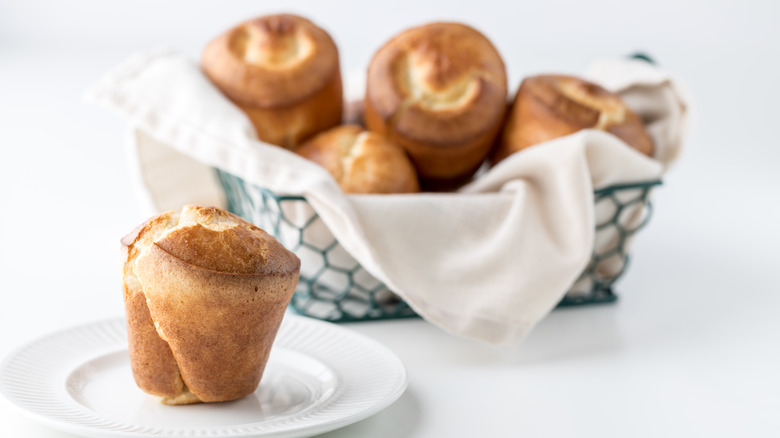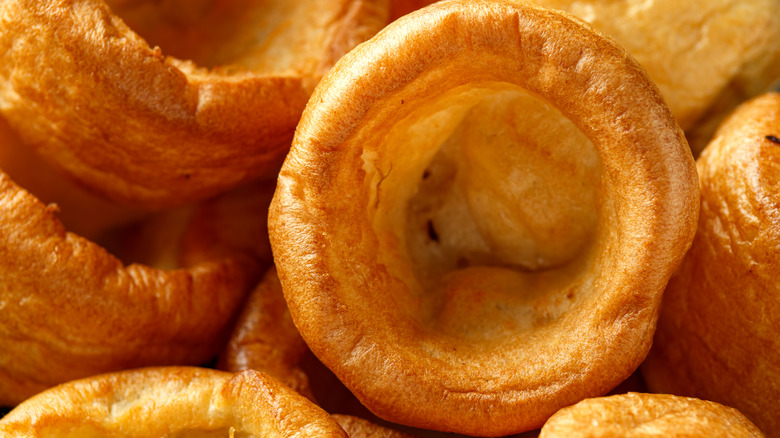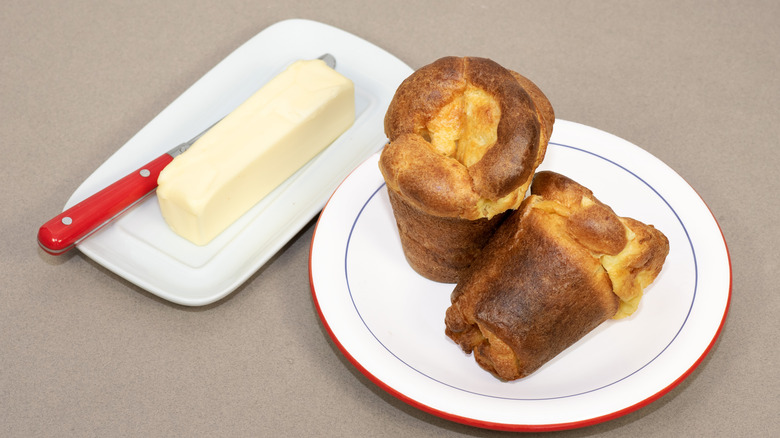The Differences Between Popovers And Yorkshire Puddings
The Northeastern United States has its own unique culinary culture. For those of you who live there, or have had the opportunity to visit, you may recognize that many of your favorite recipes are variations of English dishes. These recipes have been modified to either use New World ingredients like Indian Pudding – which is a variation of hasty pudding — or were invented out of strange but wonderful accidents like anadama bread, which is a loaf of leavened cornmeal.
The New England area (Maine, Vermont, New Hampshire, Massachusetts, Connecticut, and Rhode Island) has another well-beloved baked good called the popover. Famous for its shape and buttery flavor, it's the perfect example of European immigrants taking an old U.K. recipe and adapting it for their own means. In this case, the popover was inspired by the beloved English Yorkshire pudding, but there are some key differences between the two, and if you were to order one thinking it would taste the same as the other, you would be sorely mistaken (via MasterClass).
What are Yorkshire puddings?
Yorkshire pudding was invented in early England but according to Historic-UK, the specifics of when, where, and who invented it have been lost to time. The first printed Yorkshire pudding was released in 1747, but it is surmised that the commonwealth was baking this pudding up well before its publication. And before those of you who grew up outside the United Kingdom add the Yorkshire pudding to your list of desserts you want to give a try, it's important for you to know that this particular pudding isn't sweet, it's savory, and it isn't a pudding in the scene of a custard either.
Yorkshire pudding aka "Dripping Pudding" aka "toad-in-the-hole" (which is just a Yorkshire pudding with a sausage baked in) is made from a batter of milk, eggs, flour, and salt and works like pastry. Serious Eats says that the Yorkshire pudding is whipped into a batter and left to sit overnight, rested till it reaches room temperature before baking, and is supposed to turn out of the oven tall, light, and slightly crispy. In fact, the pudding is supposed to quadruple in size while baking so that it doesn't fall flat, which sounds similar to the concept of a New England popover.
What are popovers?
Yorkshire puddings are what eventually inspired the towering American popovers. The English colonists tried to recreate Yorkshire pudding by placing the batter into hot butter, which allowed the mixture to puff and crisp up in the oven (via Taste Atlas). Unlike Yorkshire pudding, these New World treats were not strictly savory, Mashed confirms that popovers are often served with butter and jam instead of meat and herbs. Savory versions still exist though, like this recipe for gruyere and black pepper popovers.
New York Times Cooking says that popovers and Yorkshire pudding use the same ingredients but traditionally, Yorkshire pudding relied on meat drippings (meat was often cooked above these baked goods so as not to waste a drop) for flavor and color whereas popovers just use butter (which is just as delicious in our opinion). According to BBC, a Yorkshire pudding is traditionally baked in an angled muffin pan to create that iconic large, puffed top, while King Arthur Baking claims that popovers specifically use deep-welled pans to force the batter to expand on top and create a mushroom-looking appearance. And though you could just use a simple muffin pan to bake either of these goodies, they won't have that classic shape that makes them so identifiable.


